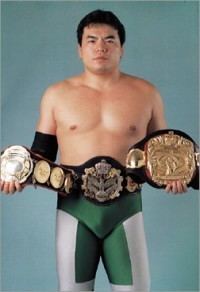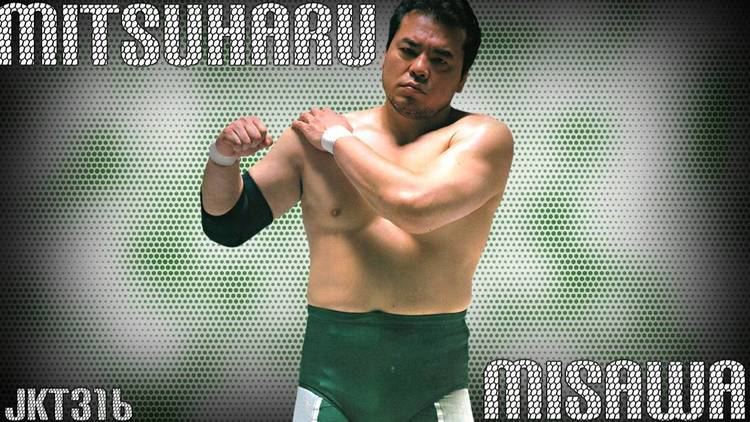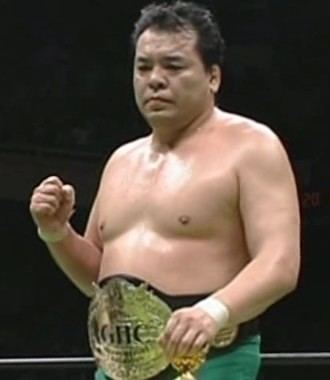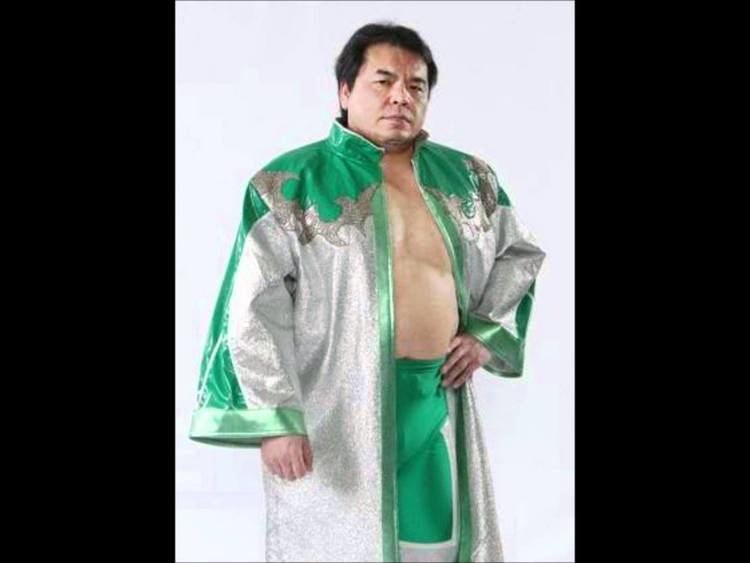Billed height 1.85 m (6 ft 1 in) Role Professional wrestler Billed weight 118 kg (260 lb) Children Kaede Misawa | Debut August 21, 1981 TV shows AWA All-Star Wrestling Name Mitsuharu Misawa | |
 | ||
Born June 18, 1962Yubari, Hokkaido ( 1962-06-18 ) Ring name(s) LionMitsuharu MisawaTiger Mask (II) Spouse Mayumi Misawa (m. 1988–2009) Similar People | ||
Pro-Wrestling NOAH - Mitsuharu Misawa "Spartan X" Theme Cover
Mitsuharu Misawa (三沢 光晴, Misawa Mitsuharu, June 18, 1962 – June 13, 2009) was a Japanese professional wrestler. He made his professional debut on August 21, 1981 for All Japan Pro Wrestling (AJPW). From 1984 until 1990, Misawa wrestled as the second generation Tiger Mask, as AJPW had purchased the rights of the Tiger Mask gimmick from New Japan Pro Wrestling (NJPW). Following the death of AJPW head booker Giant Baba in 1999, Misawa inherited the position of AJPW president. After being removed as president by a board of executives, Misawa left AJPW in May 2000 to form Pro Wrestling Noah.
Contents
- Pro Wrestling NOAH Mitsuharu Misawa Spartan X Theme Cover
- Virtual pro wrestling 2 n64 mitsuharu misawa vs toshiaki kawada
- Early life
- All Japan Pro Wrestling 19812000
- Pro Wrestling Noah 20002009
- Personal life
- Death
- Legacy
- In wrestling
- Championships and accomplishments
- References

Misawa was an eight time world champion in Japanese promotions, having won the Triple Crown Heavyweight Championship five times and the GHC Heavyweight Championship three times, additionally being the inaugural holder of the latter championship. His impact was also recognized by critics, as he was also named Wrestler of the Year by Wrestling Observer Newsletter on three occasions and holding the record for most Wrestling Observer Newsletter five star matches, with 25. Misawa is also one of only four wrestlers to have the distinction of being awarded a 6-Star rating for a match with Toshiaki Kawada in 1994. Misawa is widely regarded as one of the greatest professional wrestlers of all time.

Virtual pro wrestling 2 n64 mitsuharu misawa vs toshiaki kawada
Early life

Misawa was born in Yūbari, Hokkaidō, but soon moved with his family to Koshigaya, Saitama. He was a fan of professional wrestling, especially the All Japan product, from an early age, and wanted to drop out of school in order to begin his training. However, during an encounter with Jumbo Tsuruta, the latter convinced Misawa to complete at least his high school education, so he did. He attended Ashikaga-kodai High School in Tochigi, with future rival Toshiaki Kawada, who was only a year below him.
All Japan Pro Wrestling (1981–2000)

Misawa was a successful amateur wrestler. Competing in the junior age group, he placed fifth at the 1980 freestyle World Championships. Misawa was trained in professional wrestling by Dick "The Destroyer" Beyer, Shohei Baba, and Dory Funk, Jr.. He made his professional debut on August 21, 1981 for All Japan Pro Wrestling (AJPW), wrestling against Shiro Koshinaka. He then traveled to Mexico where he wrestled for EMLL while improving his aerial skills under the guidance of La Fiera. From August 1984 to May 1990, Misawa wrestled as the second generation Tiger Mask, succeeding Satoru Sayama, as All Japan Pro Wrestling had purchased the rights of the Tiger Mask gimmick from New Japan Pro Wrestling. In 1986, Misawa graduated to the heavyweight class after five years as a junior heavyweight. Between 1988 and 1989, he competed in championship matches for the AWA and NWA World Heavyweight Championships before a knee injury in March 1989 sidelined him until January 2, 1990. Upon his return, he wrestled Bret Hart to a time-limit draw on April 13 at the WWF/NJPW/AJPW Supershow in the Tokyo Dome. After Genichiro Tenryu's abrupt departure from AJPW later that month, Giant Baba made the decision to turn Misawa into his new rising star. During a tag match against Yoshiaki Yatsu and Samson Fuyuki on May 14, 1990, Misawa commanded his tag team partner (and future rival) Toshiaki Kawada to unmask him, thus abandoning the Tiger Mask gimmick after six years.
Weeks later, Misawa defeated Jumbo Tsuruta on June 8 in his first main event at Nippon Budokan. The match is seen as a turning point in the history of All Japan Pro Wrestling, with Misawa being established as a major threat and a new star. Misawa made his first challenge for the Triple Crown Heavyweight Championship in July, losing to Stan Hansen in a decision match for the vacant titles after Terry Gordy was forced to vacate the titles. After losing to Tsuruta in a rematch on September 1, he teamed with then-regular partner Kawada to place third in the World's Strongest Tag Determination League, beating the team of Tsuruta and Akira Taue on the final day. Misawa again challenged for the Triple Crown in April 1991, but fell to Tsuruta for a second time. Misawa continued his growth throughout 1991, pinning Terry Gordy in successive months in June and July, the second coming in an World Tag Team Championship match, where Misawa and his partner Kawada defeated Gordy and Steve Williams. The pair made their first defence against the team of Tsuruta and Taue on September 30 at Nippon Budokan, with Misawa historically forcing Jumbo to submit to end the match. On August 22, 1992, Misawa defeated Hansen to win the first of what would eventually be five Triple Crown Heavyweight Championships. The first of these title reigns lasted for almost two years before Misawa dropped the belts to Williams.
Misawa went on to dominate All Japan Pro Wrestling throughout the 1990s, with multiple World Tag Team Championship reigns, and feuds with Kawada, Kenta Kobashi, Jun Akiyama, Taue, and Williams throughout the rest of the 1990s. In 1996, he became an inaugural member of the Wrestling Observer Newsletter Hall of Fame.
Following the death of AJPW founder Giant Baba, Misawa inherited the position of AJPW president. After disagreements with widow Motoko Baba, and his removal by a board of executives in 2000, Misawa left All Japan Pro Wrestling in May 2000; followed by all but two natives (Toshiaki Kawada and Masanobu Fuchi) and two non-natives (Stan Hansen and Maunakea Mossman) to form Pro Wrestling Noah.
Pro Wrestling Noah (2000–2009)
Pro Wrestling Noah held its inaugural show, Departure, from August 5–6, 2000. Collectively, the shows featured the 23 other wrestlers that had resigned from AJPW. On July 18, 2004, Misawa returned to AJPW and defeated Satoshi Kojima at Battle Banquet; he would return once more on October 31, 2004, for the Keiji Mutoh: Love and Bump pay-per-view, where he and Mutoh defeated Hiroshi Hase and Kensuke Sasaki in what was billed as a "Special Dream Tag Match".
In 2005, Misawa and his long-time tag team partner Yoshinari Ogawa returned the GHC Tag Team Championship to Noah from the NJPW combination of Yuji Nagata and Hiroshi Tanahashi. From then until his death in 2009, Misawa continued to wrestle a full-time schedule, competing mostly in tag team matches. At the Nippon Budokan on December 10, 2006, he defeated Naomichi Marufuji to win his third GHC Heavyweight Championship. Misawa would go on to defend the GHC Heavyweight Championship against the likes of former ROH World Champion Takeshi Morishima, Takuma Sano, prominent gaijin Bison Smith and Akira Taue. On August 25, 2007, it was announced that Misawa would be on the November 2 and November 3 Ring of Honor (ROH) "Glory by Honor" cards in Philadelphia and New York City respectively.
On October 27, 2007, Misawa successfully defended the GHC Heavyweight Championship against Samoa Joe. The following week, Misawa traveled to the United States to appear at ROH's Glory by Honor VI weekend shows. On the first night, he teamed with Kenta to face Takeshi Morishima and Naomichi Marufuji, wrestling to a thirty-minute time-limit draw. The following night, he successfully defended the GHC Heavyweight Championship against Kenta. On March 2, 2008 Misawa was defeated by Takeshi Morishima for the GHC Heavyweight Championship, ending his 16-month-long championship reign.
Personal life
Misawa married his wife, Mayumi, on May 10, 1988. Together, they had at least one child, a daughter named Kaede. After his death, Mayumi became a majority shareholder in Pro Wrestling Noah. He is survived by at least one older brother. Very little else is known of Misawa's personal life. He was said to be private about his life outside of professional wrestling, to the point that wrestlers who had known him for decades had no idea he had children. He was said to have been an avid video game fan, and at one point revealed to video game magazine Famitsu a list of his favorite video games.
Death
On June 13, 2009, Misawa teamed with Go Shiozaki against GHC Tag Team Champions Akitoshi Saito and Bison Smith in a title match at Hiroshima Green Arena. After taking a belly to back suplex from Saito, Misawa lost consciousness and was taken to a hospital. He was pronounced dead in the hospital at 10:10pm JST. The cause of death was later speculated in the official police report to have been a cervical spinal cord injury that caused cardiac arrest; however, Misawa's family invoked a Japanese law that requested the police not publicly release the official cause of death. Misawa's death has caused several wrestling promotions to work toward a stronger approach to regulating professional wrestling in the country.
Legacy
Misawa's style of wrestling inspired many to call him one of the greatest of all time. CM Punk paid a tribute to him for one night only by writing "Misawa" on his wrist tape. Chris Hero adopted many of his forearm strikes into his moveset. Both William Regal and Bryan Danielson have cited Misawa as one of their heroes. Pro Wrestling Noah holds a tribute show to him every (early-mid) June to pay their respects to him. "The Dynamite Kid" Tom Billington once cited him as one of the hardest workers in the business. For a short time, Yoshi Tatsu wore tights themed after Misawa's in late 2009. Kaito Kiyomiya also wore green trunks during his early career as a tribute.
On June 30, 2017, Pro Wrestling Noah held its first-ever Mitsuharu Misawa memorial tournament in honor of his career.
Dave Meltzer inducted Misawa into the Wrestling Observer Newsletter Hall of Fame class of 1996.
